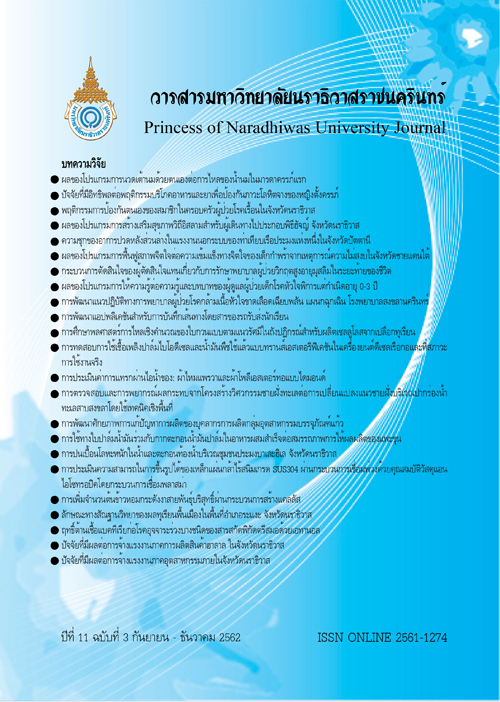ความชุกของอาการปวดหลังส่วนล่างในแรงงานนอกระบบ ของท่าเทียบเรือประมงแห่งหนึ่งในจังหวัดปัตตาน
คำสำคัญ:
ความชุก, ปวดหลังส่วนล่าง, แรงงานนอกระบบ, ท่าเทียบเรือบทคัดย่อ
การศึกษานี้เป็นการวิจัยเชิงพรรณนาแบบภาคตัดขวางเพื่อศึกษาความชุกและระดับอาการปวดหลังส่วนล่างในแรงงานนอกระบบของท่าเทียบเรือประมงแห่งหนึ่งของจังหวัดปัตตานี กลุ่มตัวอย่างที่เข้าร่วมในการศึกษามีจำานวนทั้งหมด 217 คนโดยใช้วิธีการสุ่มตัวอย่างแบบง่ายและทำาการเลือกแบบเจาะจงตามเกณฑ์การคัดเลือกกลุ่มตัวอย่าง เครื่องมือที่ใช้เป็นแบบสัมภาษณ์ประกอบด้วย ข้อมูลส่วนบุคคล ข้อมูลลักษณะการทำางานและระยะเวลาการทำางาน และ ลักษณะอาการปวดหลังส่วนล่างโดยมีค่าความเที่ยงตรงของแบบสอบถามเท่ากับ 0.9 วิเคราะห์ข้อมูลโดยสถิติเชิงพรรณนา
ผลการศึกษาพบว่าจากจำานวนแรงงานท่าเทียบเรือประมงนอกระบบทั้งหมด 217 คน มีอาการปวดหลังส่วนล่าง 149 คน
คิดเป็นร้อยละ 68.7 มีระดับคะแนนความรุนแรงช่วง 6-7 (ปวดมากพอสมควร) ร้อยละ 30.9 แรงงานมีอาการปวดหลังประมาณ
1 – 3 วัน คิดเป็นร้อยละ 33.6 แรงงานส่วนมากรักษาอาการปวดหลังด้วยการนวด คิดเป็นร้อยละ 47.0 ตามมาด้วยซื้อยาชุด
กินเองคิดเป็นร้อยละ 43.0
ดังนั้นหน่วยงานที่รับผิดชอบและนายจ้างควรจะสนับสนุนให้มีการจัดมีการให้ความรู้ สร้างความตระหนัก สนับสนุนอุปกรณ์ช่วยในการเคลื่อนย้ายของหนัก และการส่งเสริมให้แรงงานมีการปฏิบัติงานอย่างปลอดภัย ช่วยลดอาการปวดหลังส่วนล่างที่เกิดจากการทำางาน
เอกสารอ้างอิง
Bornstein, D.G., Wiesel, S.W., & Boden S.C. (2004). Low back pain: medical diagnosis and comprehensive management (3rd ed.). Saunder.
Buranatrevedh, S.& Sweatsriskul, P. (2005). Model development for health promotion and control of agricultural occupational health hazards and accidents in Pathumthani Thailand. Industrial Health, 43, 669-676.
Bureau of Occupational and Environmental Disease. (2017). Situation of occupational and environmental diseases. Ministry of Public Health.
Charuluxananan S., Thienthong, S., Rungreungvanich, M., Srirojanakul, W., Punjasawadwong, Y., & Sriprajittichai, P. (2009). A survey of post anesthetic pain management in Thailand. Journal of the Medical Association of Thailand, 92(8), 1028-1032.
Cougot, B., Petit, A., Paget, C., Roedlich, C., Fleury-Bahi, G., Fouquet, M., Menu, P., Dubois, C., Geraut, C., Roquelaure, Y.,& Tripodi, D. (2015). Chronic low back pain among French healthcare workers and prognostic factors of return to work (RTW): a non-randomized controlled trial. Journal Occupational Medicine Toxicology, 10, 40.
Ghaffari, M. (2007). Low back pain among Iraian industrial workers. Department of Public Health, KarolinskaInstitutet, Stockholm, Sweden.
Joomjee, R., Bureelerd, O., Songserm, N. & Theppitak, C. (2016). Prevalence of musculoskeletal symptoms among the para-rubber farmers. Thailand National Ergonomics Conference 2016. Retrieved 12-1-2017 from http://www.est.or.th/ErgoCon2016_Proceedings/docs/F08. pdf.
Juniper, M., Le, T.K. & Mladsi, D. (2009). The epidemiology, economic burden, and pharmacological treatment of chronic low back pain in France, Germany, Italy, Spain and the UK: a literature-based review.Expert Opin Pharmacother, 10(16), 2581-2592.
Kirkwood, B.R. & Sterne, J.A.C. (2003). Essentials of medical statistics. Oxford, UK.
Mongkonkansai, J., Veerasakul, S., Korpumn, P., Lebkhuankhiam, W., & Dumchaiyo, P. (2018). The comparison of knowledge and work-related musculoskeletal disorder preventive behaviors in Thai and Burmese fishermen: a case study at Khanom, Nakhon Si Thammarat. Disease control Journal, 44(3), 249 – 257.
National Statistical Office. (2017). The informal employment survey 2017. Retrieved from http://www.nso.go.th/ sites/2014/DocLib13/ด้านสังคม/สาขาแรงงาน/แรงงานนอกระบบ/แรงงานนอกระบบ_2560/Full_report2560.pdf.
Pengel, L.H., Herbert, R.D., Maher, C.G. & Refshauge, K.M. (2003). Acute low back pain: systematic review of its prognosis. British Medical Journal, 327(7410), 323.
Pomsunthai, K., Saeping, C., Thongngam, N., Sanguansitthikul, P., Rahong, S., Poomchaveng, S., Jantaluk, A., & Yingratanasuk, T. (2016). Factors related to muskulosketal disorder among fishery workers at Angsila pier, Con Buir province. Thailand national ergonomics conferences 2016. 79-90.
Ransford, A.O., Cairms, D. & Mooney, V. (1976). The pain drawing as an aid to psychologic evaluation of patients with low-back pain. Spine, 1(2),127-134.
Rujipachgul, J. (2012). An integrated model of informal labour management system: the case of UdonThani municipality. Journal of the research promotion association, 3(3),165.
Sakboonyarat B., Chokcharoensap, K., Meesaeng, M., Jaisue, N., Janthayanont, D., & Srisawat, P. (2018). Prevalence and association factors of low back pain (LBP) among adolescents in Central, Thailand. Global Journal of health Science, 10(2), 49-59.
Shmagel A., Foley R. & Ibrahim H. (2016). Epidemiology of chronic low back pain in US adults: data from the 2009-2010 national health and nutrition examination survey. Arthritis Care Res (Hoboken),68(11), 1688-1694.
Sornwisuit,C.(2012).Good news for person who suffered from back pain.Bangkok:Conceptpublishingcompany.
Tangkittipaporn, J. & Jiangsathaporn, W. (2017). Musculoskeletal pain and mental agony reacting to ergonomic risks in the Thai informal working environment. Psychology Research, 7(2), 73-88.
Untimanon, O., Boonmeephong, K.,Saipang T., Sukanun, K., Promrat, A., Julraung, P., Pronpiroonrod, S.,& Bureau of Occupational and Environmental Diseases, Department of Disease Control. Burden of back pain among working population. Disease Control Journal, 42(2), 119-129
Xu, G. (2012). Prevalence of low back pain and associated occupational factors among Chinese coal miners. Journal of BMC Public Health, 1.




